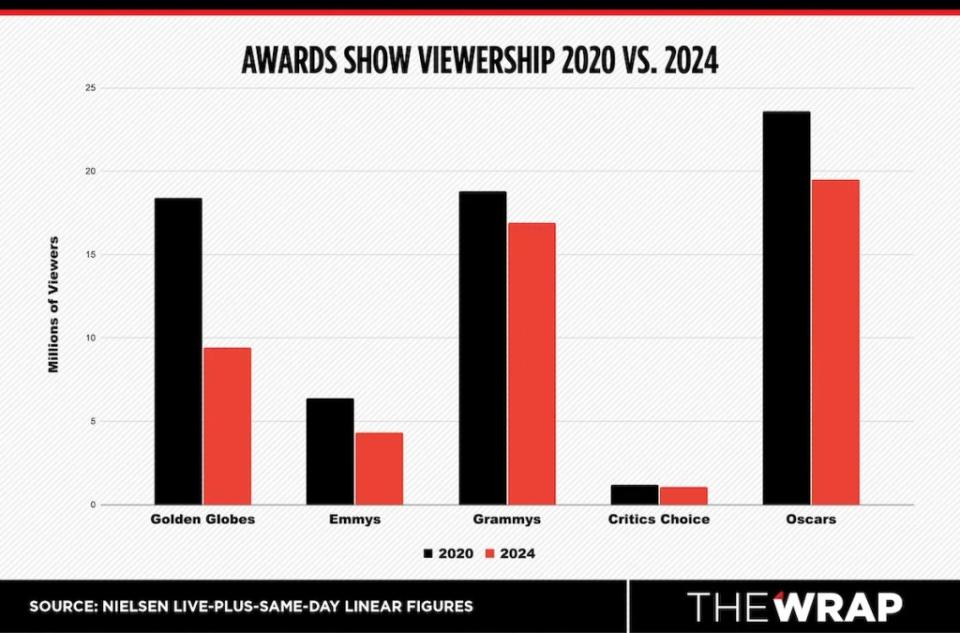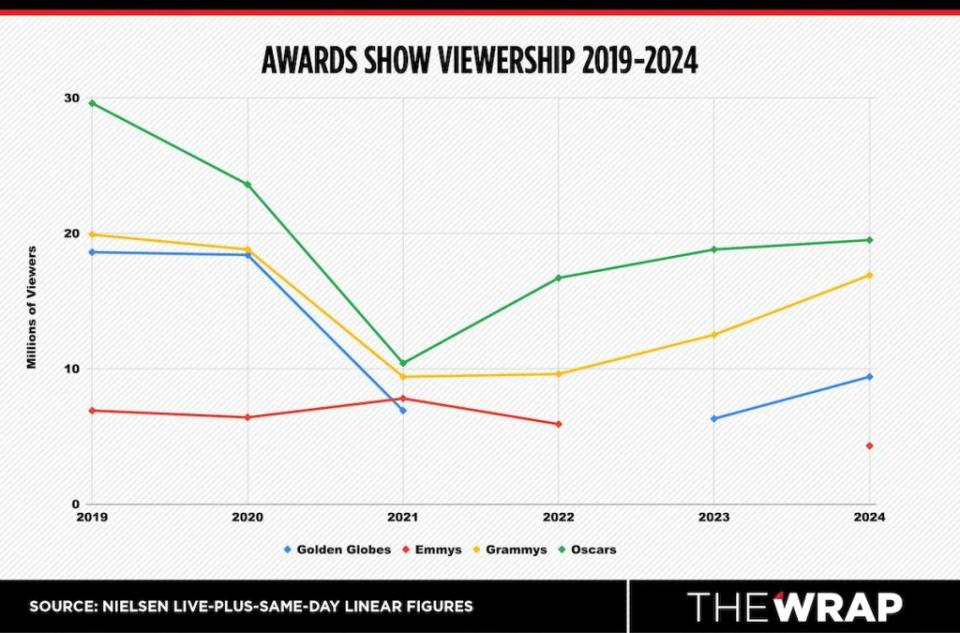From Taylor Swift to John Cena, Viral Moments Fueled Awards Show Ratings Successes
- Oops!Something went wrong.Please try again later.
- Oops!Something went wrong.Please try again later.
- Oops!Something went wrong.Please try again later.
As this year’s awards season comes to a close, even the biggest awards buffs might forget the near sweep by “Oppenheimer” at the Oscars — and instead remember John Cena’s near streak.
Leaning in to buzzy, viral moments at the Oscars — such as Ryan Gosling’s memorable rendition of “I’m Just Ken” and Martin Scorsese’s subsequent delight, or Miley Cyrus’ ad-libbed celebration of her first Grammy win — boosted nearly all of Hollywood’s awards shows to their biggest audiences since before the pandemic.
As linear viewership declines, zeitgeist-grabbing interactions and viral clips have proven critical to luring audiences back to awards ceremonies — whether they’re manufactured or not.
“Ultimately, successfully attracting viewers to watch awards shows means giving the audience something to care about,” critic and Critics’ Choice member Sean Boelman told TheWrap. “This year, we had the perfect storm of popular nominees and shareable moments to convince people to tune in.”
Boelman noted that Oscars viewership peaked during Gosling’s performance and “Oppenheimer’s” Best Picture win. (Sorry, Cena.)
In fact, ratings for the Golden Globes, the Grammys and the Oscars all trended upward from last year with double-digit percentage increases — inching closer to numbers not seen since the 2020 awards season. The COVID-19 pandemic prompted a steep ratings drop in 2021, which lingers to this day.
The 2024 awards season kicked off with the Golden Globes in January, whose viewership was up 50% from last year with 9.4 million viewers on CBS, its biggest audience since the 2020 ceremony drew 18.4 million viewers on NBC. Ratings for the Globes were undoubtably boosted by Taylor Swift’s A-list presence as a nominee, as her mysterious conversation with Selena Gomez stirred up speculation across social media. (The Swift ratings effect was seen again a month later when the Super Bowl LVIII scored its biggest audience ever with 123.7 million viewers.)
Though on a smaller scale, the Critics Choice Awards also saw a 14% uptick in viewership with its January show bringing in 1.04 million viewers on the CW — though the show was still shy of its 2020 viewership of 1.2 million.

Candid, buzzy moments also filled the 2024 Grammys in February, which brought in 16.9 million viewers on CBS, marking a 34% uptick from the previous ceremony while still coming just short of the 18.8 million viewers brought in by the 2020 show.
Tricks up producers’ sleeves
While audiences relished in seeing favorite stars craft their own surprising yet memorable moments — from Swift announcing her new album to Meryl Streep arriving late and hugging host Trevor Noah— Grammys producers had some tricks up their sleeves with surprise performances from 80-year-old Joni Mitchell (who was performing for the first time at the Grammys), Tracy Chapman and a cameo from Celine Dion. The show got a bit heated when Jay-Z called out the Grammys for snubbing his wife, Beyoncé, in the Album of the Year category despite her being the winningest performer in Grammys history.
But viral moments can be tricky to engineer. The Emmys, which aired in January off its usual cycle due to delays from the WGA and SAG-AFTRA strikes, was well-positioned for ratings growth as the 75th annual show was packed with nostalgic reunions from the cast of “Grey’s Anatomy,” “The Sopranos,” “Cheers,” “All in the Family” and “Ally McBeal,” among others. And the show featured buzzy candid moments, including Niecy Nash thanking herself while accepting her Emmy.
Instead, the Emmys hit a record ratings low with 4.3 million viewers on Fox, marking a 27% decline in viewership from last year’s previous record low viewership of 5.9 million. TV’s biggest night has long struggled beyond the pandemic to capture ratings success, with the fall 2019 pre-pandemic ceremony similarly reaching its smallest audience at the time with 6.9 million viewers.
With the hope of trending upwards like most of its awards show counterparts, Oscars producers told TheWrap ahead of the show they were leaned in to crafting moments of “connection” with the audience. “One of our goals is giving people a show that they care about,” said EP and showrunner Raj Kapoor.
“We all feel super lucky that we’re producing the Oscars in the year with so many popular movies. ‘Barbenheimer’ was a huge deal at the box office, and going to the cinema is an event again,” executive producer Katy Mullan told TheWrap ahead of the show, adding the team was planning on sprinkling in a “healthy dose” of “Barbenheimer.” “We’re finding ways to celebrate all the Best Picture [nominees], as well as all the best songs.”
While Boelman noted blockbusters “Barbie” and “Oppenheimer” heightened the ceremony’s stakes for broader audiences, a veteran awards strategist who requested anonymity to speak candidly pointed to the social media buzz generated by Messi, the dog in “Anatomy of a Fall,” noting how smaller films similarly found their footing their with general audiences.

Beyond anticipated performances of “What Was I Made For?” and “I’m Just Ken” from “Barbie,” this year’s Oscars revisited a format from the 2009 show that brought out former winners in the four major acting categories to present the nominees. Ahead of the show, EP Molly McNearney told TheWrap that producers identified connections between current nominees and former winners to make the moment “much more personal,” such as when Rita Moreno, the first Latina to ever win an Oscar, gave a touching tribute to America Ferrera.
“The Oscars continue to serve as a critical platform for highlighting industry trends, such as the push toward greater inclusivity and diversity, which resonate with broader societal movements,” said Stacy Jones, cofounder and CEO of Hollywood Branded, a pop culture creative agency.
While leaning into moments of connection — as well as the summer’s “Barbenheimer” craze — prompted the Oscars to see a 4% uptick in viewership from last year as it reached 19.5 million total viewers, the Academy Awards still fell shy of their 2020 viewership of 23.6 million. Even when taking into account multiplatform delayed viewership, the 96th Academy Awards telecast drew 21.01 million total viewers after seven days of viewing on ABC, Hulu and digital platforms — still falling nearly 5 million viewers short of the 2020 seven-day multiplatform viewership of 25.80 million.
The SAG Awards similarly attempted to lean on viral moments as the show live streamed on Netflix for the first time in the ceremony’s history, with EP Baz Halpin noting how the live stream limits the opportunity for nominees to get up from their seats and interact with other guests during commercial breaks. Instead, Halpin predicted these moments of “camaraderie” and “admiration” might translate into the live stream.
While the show captured several memorable moments — including a planned “Devil Wears Prada” reunion on stage with Emily Blunt, Anne Hathaway and Meryl Streep, and Melissa McCarthy’s request for Billie Eilish to sign her face as the pair presented an award together — the Netflix live stream inevitably drew in a smaller crowd than its broadcast counterparts. The awards show failed to rank within the 10 most-watched TV shows globally, but notably was the ninth most-watched TV program of the week in Canada.
While Netflix did not release exact viewing metrics, the ceremony did not top the 2.1 million views brought in by “The Tourist” Season 1, which placed in 10th on the English TV list during the week of Feb. 19. Viewership data for the SAG Awards will likely remain unknown until the streamer releases its data transparency report for the first half of 2024.
Despite this year’s growth, it remains uncertain whether awards shows can rebound fully to their pre-pandemic numbers amid declining linear viewership, as Jones notes this year’s viewership reflects larger shifts across media.
“The proliferation of streaming services, the fracturing of traditional television audiences, and a year-round cycle of entertainment content have fundamentally altered how and when audiences engage with tentpole events like the Oscars,” Jones said. “The reality is, it’s surprising that viewership has not actually dropped off even more in recent years due to that landscape of declining viewership overall.
Nonetheless, a regained an appetite for live events, especially those that can guarantee star sightings and buzzy interactions, has been proven by this year’s growth, though “the challenge and opportunity for the Academy and broadcasters lie in harnessing the power of viral moments and star-studded commercials, alongside the prestige of the awards themselves, to navigate the shifting media landscape,” per Jones.
“You never know when something’s going to become culturally relevant or go viral,” the veteran awards strategist said, adding that the return to movie theaters is a promising sign for awards shows. “People will go to the movies when you give them something great to see. I’m hopeful that the ratings will go up — I’m hoping that there are more viral moments — whatever those moments are — that draw interest and eyeballs on a show that is near and dear to many of us.”
The post From Taylor Swift to John Cena, Viral Moments Fueled Awards Show Ratings Successes appeared first on TheWrap.

